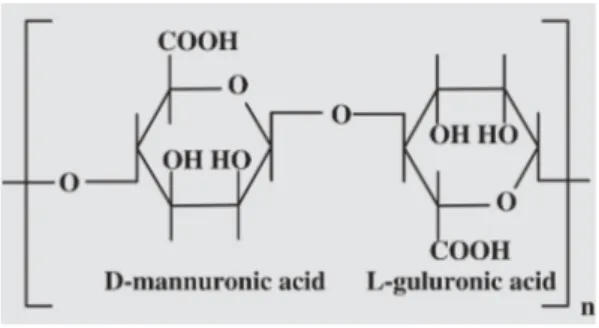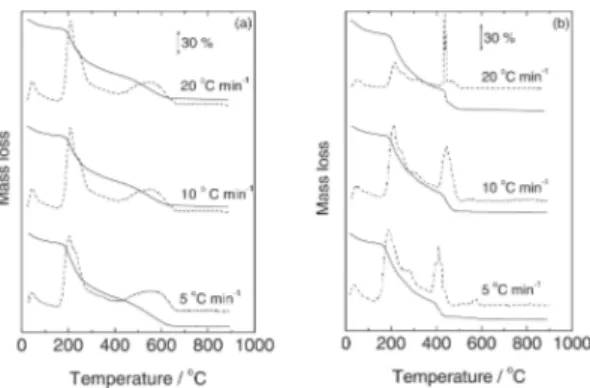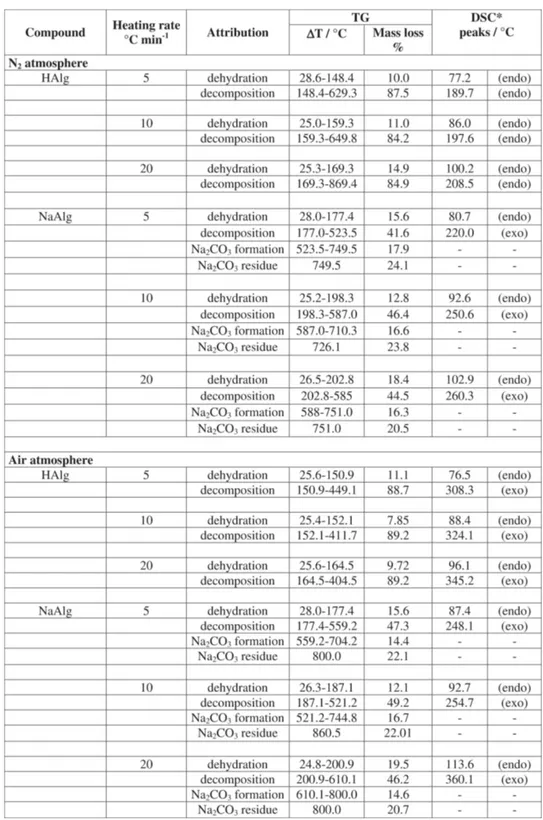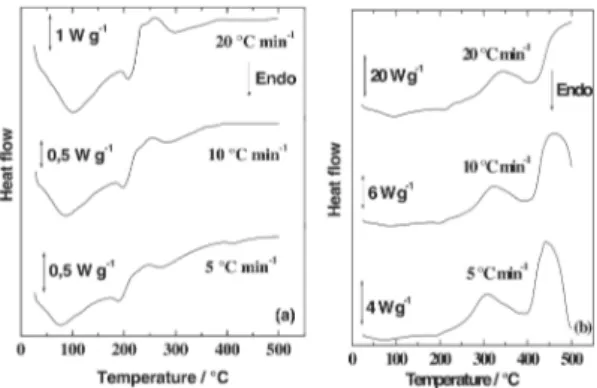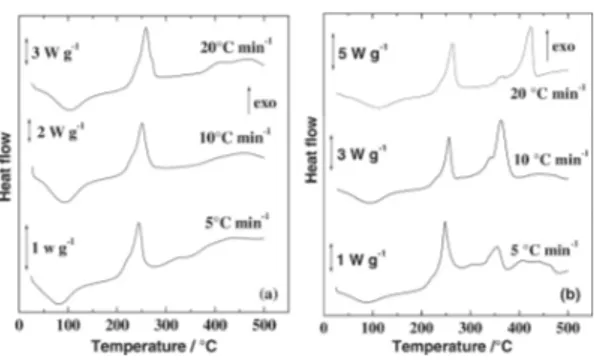Volume 29, número 2, 2004
www.scielo.br/eq
Thermal behavior of alginic acid and its sodium salt
J. P. Soares1, J. E. Santos1,2,G. O. Chierice3,E. T. G. Cavalheiro3
1 Departamento de Química - UFSCar - 13565-905 - São Carlos – SP - Brasil 2 Departamento de Ciências Exatas e Natureza - UFCG - 58900-000 - Cajazeiras – PB - Brasil 3 Departamento de Química e Física Molecular - IQSC - USP 13560-970 - São Carlos – SP - Brasil
___________________________________________________________________________________________________________________________________________________________________________________________________________________________________________
Abstract: An evaluation of hydration and thermal decomposition of HAlg and its sodium salt is
described using thermogravimetry (TG) and differential scanning calorimetry (DSC). TG curves in N2 and air, were obtained for alginic acid showed two decomposition steps attributed to loss of water and polymer decomposition respectively. The sodium alginate decomposed in three steps. The first attributed to water loss, followed by the formation of a carbonaceous residue and finally the Na2CO3. DSC curves presented peaks in agreement with the TG data. In the IR alginic acid presented bands at 1730 and 1631 cm-1, while sodium alginate presented a doublet at 1614 e 1431 cm-1, evidencing the
presence of salified carboxyl groups.
Keywords: alginic acid; thermogravimetry; differential scanning calorimetry.
_________________________________________________________________________________
Introduction
The HAlg (Figure 1) is a copolymer derived from the 1,4-linked-b-D-mannuronic (M)
and a-L-guluronic (G) acids [1], containing
carboxylic groups in their structures that define the adsorption capacity for metals [2,3].
Figure 1. Chemical structures of components of the alginic acid.
According to Haug et al [4] and Aspinall
[5] in alginates both residues can be combined to form homopolymer blocks (M-block, G-block) or copolymer blocks (MG-block) with several
possible polymers. Each seaweed can present a specific proportion of M and G units, with a specific alginic acid from each species.
The biological properties of polysaccharides, especially of the algínates, have been explored since many decades in countless medical and surgical applications. Those properties, and the solubility in water, are due to the presence of inorganic ions in the alginate structure6.
Alginic acid form water-soluble salts with monovalent cations but is precipitated upon acidification. Alginates of many bivalent cations, particularly of Ca2+, Sr2+ and Ba2+, are insoluble in
water and can be prepared when sodium ions of NaAlg are replaced by di- and trivalent cations. This property is used in the isolation of alginic acid from algae [7,8].
employed in the preparation of gels for the delivery of biomolecules such as drugs, peptides and proteins [10].
Toxicological data showed that alginates are safe when used in food. HAlg and its derivatives acts as stabilizers and thickeners facilitating the dissolution and improving viscosity of the ingredients preventing the formation of crystals that will prejudice the appearance and homogeneity, mainly in frozen products [11].
Nakamura et al. [12] investigated the
thermal properties of water insoluble alginate films containing di and trivalent cations. The results indicated that the alginates form compact structures when the ionic radii of the cation is lower. Changes in the film structure during ionic exchange were studied on the basis of its glass transition temperature (Tg) and heat capacity using differential scanning calorimetry (DSC).
Hatakeyama et al. [13] determined the
non-freezing water contents of mono and divalent cation salts of some polyelectrolites. The number of water molecules strongly bounded to the cations influences remarkably the polyelectrolite structure. Said et al. [14] investigated the thermal
and electrical properties of silver, selenium and uranyl alginates using thermogravimetry and differential scanning calorimetry, concluding that metal oxalates were formed as decomposition intermediate.
Considering the importance of this polysaccharide and its derivatives and the lacking in information about its thermal behavior, the present work describes the purification, characterization and the thermal decomposition of the alginic acid and sodium alginate.
The thermal analysis is also important considering the fact that in industrial processes heat is commonly employed and the thermal decomposition data yields information regarding the stability and residues of decomposition. Water content is another important parameter that can be extracted from thermal measurements.
Experimental
Reagents and solutions
All the reagents were of analytical grade and used without further purification, except when indicated.
Purification of the HAlg
Alginic acid (Aldrich) was purified by dissolving 5 g in 0.5 mol L-1 NaOH and stirring
for two h with a magnetic stirrer. After that 0.5 mol L-1 HCl was added slowly until pH 2-3 and
stirred for 24 h. The resulting gel suspension was filtered in a quantitative filter paper and washed with ethanol. The resulting solid was then dried in a vacuum oven at 40 °C for 24 h. This purification procedure was performed since the commercial reagent presented sodium residue when submitted to thermogravimetric analysis and the conductimetric titration suggested that some carboxyl groups were not free.
Complete dehydration of both acid form and sodium salt was achieved only whether the compounds were used just after drying in a vacuum oven.
Conductimetric titration
Conductimetric titrations were performed by suspending 300 mg of alginic acid in 30.0 mL of water. 10.0 mL of 0.0969 mol L-1 HCl solution
were added to this solution. The excess of HCl was titrated with 0.505 mol L-1 NaOH in a
thermostated conductimetric cell at 25.0 ± 0.1 °C kept with a MA 184/6 thermostatic bath (Marconi).
Thermal analysis
Thermogravimetry (TG) measurements were performed in a TGA-2050 thermogravimetric modulus coupled to a TGA-2100 thermal analyser (both from TA Instruments) using sample mass of
ca. 7 mg and an alumina sample holder at heating
rates of 5, 10 and 20 °C min-1 under a dynamic air
and nitrogen atmospheres flowing at 90 mL min -1. Humidity and ash contents were determined by
means of two determinations, with the help of the first derivative thermogravimetry (DTG) data under atmospheric pressure.
Differential scanning calorimetry (DSC) measurements were performed in a DSC-910 modulus coupled to a TGA-2100 thermal analyser (both from TA Instruments) using sample mass of 4,0 mg in a covered aluminum sample holder with a central pin hole at heating rates of 5, 10 and 20 °C min-1 under dynamic air and nitrogen
atmosphere, flowing at 90 mL min-1 under
Elemental analysis, IR and 1H NMR spectroscopy
The C and H contents in the samples were determined in a EA1108-CHN-S elemental analyser (Fisons). IR spectra were recorded in KBr pellets from 4000 - 400 cm-1 in a MB102 FT-IR
(Bomen-Michelson). The 1H NMR spectra were
recorded in a BZH 200/52 spectrometer (Brüker).
Results and discussion
Characterization of the HAlg and NaAlg
The elemental analysis of the samples are in agreement with the general formula (C6H8O6)n for HAlg and (C6H7O6Na)n, only after complete dehydration. Dry material was obtained after 24 h under vacuum at 40 °C and the elemental analysis being performed just after removing from the oven and keeping in a dessicator under vacuum. If the compounds are manipulated at atmospheric air, they rapidly re-hydrate by absorbing water from the environment.
IR spectra obtained for the HAlg and NaAlg in the 2000 – 800 cm-1 range, presented the
stretching of the C=O group of the protonated carboxylic group at 1730 and 1631 cm-1. When
the proton is displaced by a sodium ion, the peaks are observed at 1614 and 1431 cm-1 and they are
assigned to the symmetric and antisymmetric COO
-stretching vibrations of the free carboxyl group as observed by Huang et al. [15].
Yeom [16] reported similar results when measuring the alginate content in films using IR. According to Chandia [17], the alginates FT-IR spectra present bands around 800 e 700 cm-1,
relative to mannuronic and guluronic acids respectively.
The main difference of the 1H NMR
spectra of acidic form is the singlet signal at 5.04 ppm assigned to carboxylic proton, which disappeared in the sodium salt spectra, according to the literature [17]. The spectra are also independent on the amount of G and M monomers since they are structural isomers.
Conductimetric titrations of excess HCl added to the alginic acid allowed to the determination of the number of acidic sites in the polymeric matrix. This number was determined in the range of 0.87 ± 0.07 (n = 3) and 0.99 ± 0.02 mol (n = 3), for carboxylic groups per mol of commercial and purified alginic acid, respectively.
Thermal analysis of HAlg and NaAlg
Initially, a study of the influence of heating rate in the thermal behavior of HAlg and NaAlg was performed under both air and N2 atmospheres. Since every synthetic or natural polymer containing hydrophilic groups usually presents strong interaction with water, the humidity content may influences their properties and is an important characteristic to be determined [13].
Thermogravimetry is a technique that can yield information about humidity and ash contents in a simple and fast way, but factors such as heating rate present a severe influence on the resolution of the TG curve [18,19] and the definition of this parameter is fundamental for a thermogravimetric investigation.
Table 1 presents the percentage for humidity and decomposition mass losses, temperature ranges and residues for the alginic acid and sodium alginate at 5.0; 10.0 and 20.0 °C min-1 heating rates in both air and N
2 atmospheres
as well as the related DSC peaks.
The TG curves presented in Figure 2 suggest that, under heating, the alginic acid presents initially a dehydration process followed by decomposition in two overlapping steps under nitrogen (Figure 2a), without residue at the end of the experiment. Similar behavior was observed in air (Figure 2b). The decomposition product around 400 °C was characterized as a carbonaceous material in both cases.
Figure 3 shows the TG curves for the sodium alginate. According to such a results, the salt decomposed by dehydration followed by degradation to Na2CO3 and a carbonized material that decomposes slowly from 600-750 °C in N2 (Figure 3a). According to Newkirk [20] the Na2CO3 decomposition is dependent of the sample holder and atmosphere used. In this work such decomposition appeared above 800 °C in agreement with the findings of those author using Pt crucible and N2 atmosphere. Under air (Figure 3b) the dehydration occurs in a similar way, but the decomposition of the carbonized material is faster, around 600 °C, resulting in Na2CO3 that decomposes as described in N2. The presence of Na2CO3 and carbonized residue was confirmed by heating the compound up to 550 °C, in an oven under the respective atmosphere and addition of HCl to the degradation product. A vigorous liberation of CO2 was observed while a dark insoluble residue remained in the test tube, in both cases. If the residue percentage is correct for the water content values close to the expected 26.75% for ½ Na2CO3 for each C6H7O6Na unit can be found.
Figure 3. TG (solid)/DTG(dashed) curves of sodium alginate under N2 (a) and air (b) under flow of 90 mL min-1 in different heating rates.
The presence of the metallic oxalates instead of carbonates as decomposition intermediates is a difference from the results observed by Said et al. [15] for alginates of Ag+,
Se4+ and UO 2
2+, in relation to the sodium salt.
As presented in Figures 2 and 3, the TG general profiles for each compound did not change markedly with these heating rates. It is possible to
observe from the data in Table 1 that the humidity values changed depending on the heating rate which can be related with the influence of the heating rates on the resolution of the dehydration step [18,19], as observed in the DTG curves. The ash contents are not severely affected by the heating rate. Similar results were obtained in all the scan rates, but at 20°C min-1 some overlap of
the thermal events can occur. So it was concluded that at 10°C min-1 a better compromise between
resolution and time of analysis can be reached and this was the heating rate chosen for the further analysis.
Figures 4 and 5 show the DSC curves, showing the heating rate influence on the thermal behavior of HAlg and NaAlg under both air and N2 atmospheres, respectively.
Under N2 (Figure 4a), HAlg decomposed showing three overlapping peaks. The first endothermic peak suggests the dehydration process at around 80 °C. Then, an endothermic peak close to 200 followed by an exothermic peak at ca. 240 °C, respectively, has appeared. Such
processes were attributed to the decomposition of the polymer resulting in the carbonized residue, in agreement with TG results.
Figure 4b shows the thermal behavior of the HAlg in air atmosphere. The endothermic peak, centered between 75 and 96 °C depending on the heating rate, may be attributed to the dehydration process. The small endothermic process at 190 °C followed by a strong exothermic peak at c.a. 300
°C, correspond to the decomposition of the biopolymer. The TG/DTG data are in agreement with this assumption.
and 340-410 °C (depending on the heating rate) may be attributed to the decomposition of the biopolymer and formation of the respective carbonate, which is in agreement with TG curves.
Conclusion
According to the present results it can be concluded that the heating rate do not presented significant influence on the TG and DSC profiles from 5 – 20 °C min-1. This suggests that higher
heating rates can be used with gain in experimental time.
The alginic acid decomposed in two successive steps after dehydration under both air and nitrogen atmospheres, without residue in the sample holder at 700 °C. The sodium alginate decomposes also in two steps after the dehydration process. The decomposition leads to a Na2CO3 residue, the decomposes above 750 °C under nitrogen, due probably to the presence of carbonaceous residue and is stable under air atmosphere where the carbonaceous residue is totally decomposed above 600 °C. these differences in the Na2CO3 behavior have been already described by Newkirk [20].
Recebido em 30/04/04 Aceito em 21/07/04 The DSC curves of NaAlg under N2 are
presented in Figure 5.a. The dehydration was evidenced by an endothermic peak close to 100 °C, then the decomposition of the biopolymer takes place represented by an exothermic peak at c.a.
240-260, depending on the heating rate. Finally the decomposition of the carbonaceous material occurred above 300 °C.
Figure 5. DSC curves the sodium alginate under N2 (a) and under air (b) flow of 90 mL min-1 in different heating rates.
Under air (Figure 5b), the NaAlg presented a first endothermic peak at 100 °C attributed to the water release. The second and third exothermic peaks with a maximum at 250
J. P. Soares, J. E. Santos,G. O. Chierice,E. T. G. Cavalheiro. Comportamento térmico do ácido algínico e do seu sal de sódio.
___________________________________________________________________________________________________________________________________________________________________________________________________________________________________________
Resumo: Uma avaliação da hidratação e de decomposição térmica do HAlg e seu sal de sódio foi
realizada usando termogravimetria (TG) e a calorimetria exploratória diferencial (DSC). As curvas TG em N2 e ar, para o ácido algínico apresentaram duas etapas de perda de massa correspondendo à saída de água e posterior decomposição do polímero. Já para o alginato de sódio, a decomposição térmica ocorreu em três etapas. A primeira corresponde à liberação de água, seguida da formação de resíduo carbonizado e formação do carbonato de sódio. As curvas DSC concordam com os eventos observados em TG. Na região do infravermelho, o ácido algínico apresentou bandas em 1730 e 1631 cm-1, enquanto
o alginato de sódio apresentou duas bandas em 1614 e 1431 cm-1, evidenciando a presença de grupos
carboxílicos salificados.
Palavras-chave: Ácido algínico; termogravimetria; calorimetria exploratória diferencial.
___________________________________________________________________________________________________________________________________________________________________________________________________________________________________________
References
[1] X. Liu, L. Qian, T. Shu, Z. Tong, Polym. 44
[3] C. Jeon, J. Y. Park, Y. J. Yoo, Water Res. 36 (2002) 1814.
[4] A. Haug, B. Larsen, Acta Chem. Scand. 16 (1962) 1908.
[5] G. O. Aspinall, The polysaccharides, Academic Press, New York, 1983, vol. 2.
[6] S. Oerther, E. Payan, F. Lapicque, N. Presle, P. Hubert, S. Muller, P. Netter, Biochim. Biophys. Acta 185 (1999) 1426.
[7] K. Nakamura, E. Kinoshita, T. Hatakeyama, H. Hatakeyama, Thermochim. Acta 171 (2000) 352.
[8] A. I. Usov, Russ. Chem. Rev. 68 (1999) 957. [9] A. Ikeda, A. Takemura, H. Ono, Carbohydr. Polym. 42 (2000) 421.
[10] T. W. Wong, L. W. Chan, S. B. Kho, P. W. S. Heng, J. Controlled Release 84 (2002) 99. [11] D. F. Othmer, R. E. Kirk, Encyclopedia of Chemical Technology, John Wiley, New York, 3rd., 1980.
[12] k. Nakamura, Y. Nishimura, H. Hatakeyama, T. Hatakeyama, Thermochim. Acta 267 (1995) 343.
[13] T. Hatakeyama, H. Hatakeyama, K. Nakamura, Thermochim. Acta 253 (1995) 137. [14] A. A. Said, M. M. M. Abd El-Whab, R. M. Hassan, Thermochim. Acta 233 (1994) 13. [15] R. Y. M. Huang, R. Pal, G. Y. Moon, J. Membrane Sci. 160 (1999) 101.
[16] C. K. Yeom, K. H. Lee, J. Appl. Polym. Sci. 67 (1998) 209.
[17] N. P. Chandía, B. Matsuhiro, A. E. Vásquez, Carbohydr. Polym. 46 (2001) 81.
[18] E. T. G. Cavalheiro, M. Ionashiro, S. T. Brevigliere, G. Marino, G. O. Chierice, Quim. Nova 18 (1995) 305.
